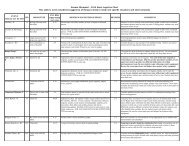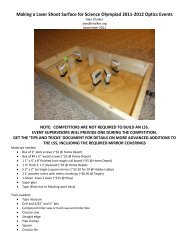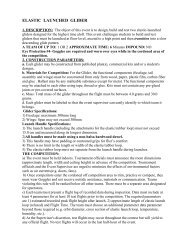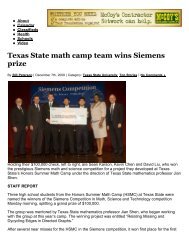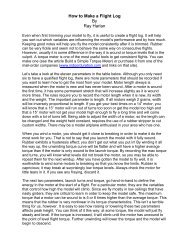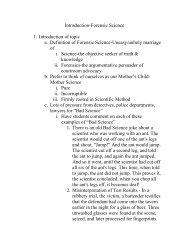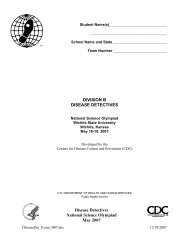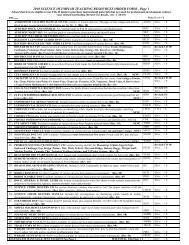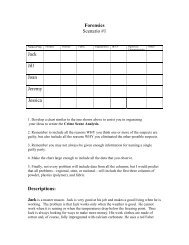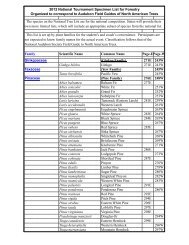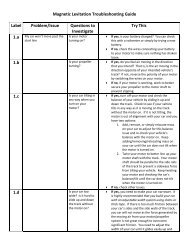Straw Tower Challenge - Science Olympiad
Straw Tower Challenge - Science Olympiad
Straw Tower Challenge - Science Olympiad
Create successful ePaper yourself
Turn your PDF publications into a flip-book with our unique Google optimized e-Paper software.
STRAW<br />
TOWER<br />
CHALLENGE<br />
INSTRUCTIONS FOR TEACHERS<br />
With all the excitement surrounding the construction of several new skyscrapers in Chicago (the 92-story<br />
Trump International Hotel & <strong>Tower</strong>, Santiago Calatrava’s 2000-foot-tall Chicago Spire), the <strong>Science</strong> in the<br />
City “<strong>Straw</strong> <strong>Tower</strong> <strong>Challenge</strong>” reflects the rich architectural and engineering history of our great hometown.<br />
Your challenge as a teacher will be to turn a handful of straws and a roll of tape into a meaningful science<br />
activity. You might find skepticism among your students who will ask, “Can we really build a tall tower with<br />
straws?” But once presented with the materials, skyscrapers will arise from desks, floors and tabletops,<br />
reaching unexpected heights of creativity.<br />
We at <strong>Science</strong> <strong>Olympiad</strong> have provided you with a special set of instructions, containing a detailed daily<br />
calendar, extension activities for students, a tower log, a sketch sheet and four pages of engineering tips<br />
that will help you form the building blocks of a successful tower design. (Please feel free to copy these<br />
pages for your internal school use.) <strong>Science</strong> <strong>Olympiad</strong> takes pride in aligning all its events to National<br />
<strong>Science</strong> Standards as well as State Standards, and the <strong>Straw</strong> <strong>Tower</strong> <strong>Challenge</strong> meets both:<br />
STRAW TOWER BUILDING – The objective of this event is to design and build a straw tower with the<br />
highest structural efficiency capable of supporting a standard load. Teams should maintain and<br />
submit a log at check-in containing data to help them improve future designs.<br />
M.E.1.b-d<br />
E. <strong>Science</strong> and Technology – An understanding of science and technology establishes connections<br />
between the natural and designed world linking science and technology.<br />
M.E.1 Abilities of technological design<br />
b. Design a solution or product.<br />
c. Implement a proposed design.<br />
d. Evaluate completed technological designs or products.<br />
Illinois Learning Standard 11.B concerning knowledge and application of the concepts, principles and<br />
processes of technological design.<br />
Below are a few sample ways to utilize the following engineering tip pages. Be sure to have students record<br />
all observations in the <strong>Tower</strong> Log:<br />
Basic <strong>Tower</strong> Design - Ask students about towers they have seen that look like the Basic <strong>Tower</strong> Design<br />
drawing (cell phone towers, electricity towers, the John Hancock Building). Identify the main parts of a<br />
tower (legs, columns, braces). Explain the job of each per the handout.<br />
Simple Structures - Take a moment before the first lesson to assemble a few of the shapes with straws<br />
that will form the building blocks of a sample tower (square, triangle, pyramid and cube). Let the students<br />
touch and examine the shapes. Push, pull and bend the shapes to see how they react and analyze the<br />
strength of each shape. Discuss why triangles are stronger and show how they are used as reinforcing<br />
cross braces on towers. (How about making a column by bundling cables?)<br />
Analysis of Structures - Now illustrate the concepts of what will happen when you apply stress, pressure or<br />
a load to a tower. Use your shapes as a base and test with your hand or an object. What can students do<br />
in their design to reduce strain, stress, bending or shearing? Let each student experiment with a straw.<br />
Joints - Demonstrate and practice the proper way to wrap tape around the straws. Build a butt joint with<br />
adjoining straws for the longest section. Will it bend at the joint? Overlap the tips of two straws then<br />
tape. Is it stronger than the butt joint? Slip one straw into another and wrap the slip joint with tape. The<br />
section is shorter, but is it stronger? This exercise is vital to tower assembly and maximizing tower height.<br />
PAGE - 2



